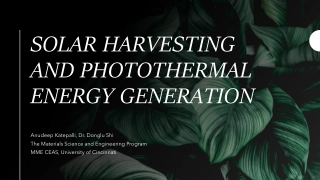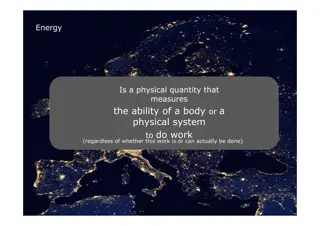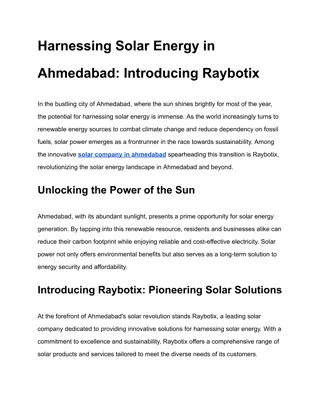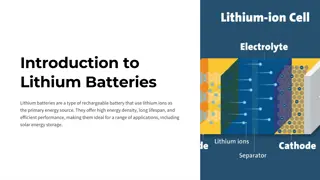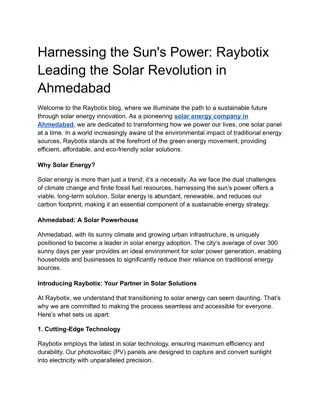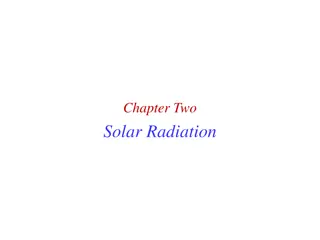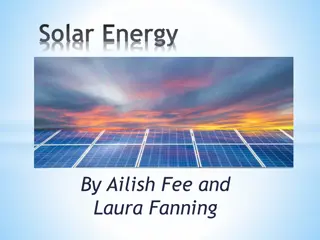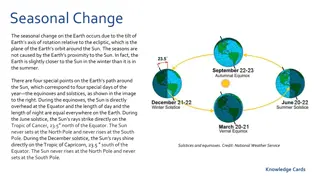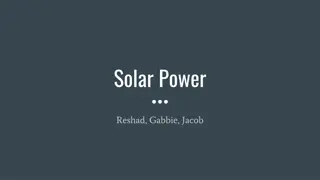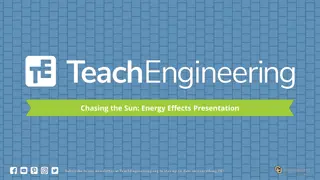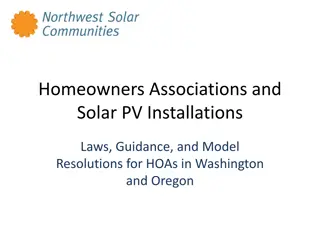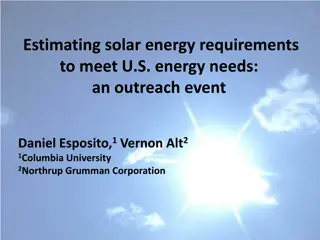
Solar Energy and Electricity Generation: Insights and Impacts
Explore the world of solar energy, electricity generation, and the fascinating processes happening in our sun. Discover key terms, units, and transformations, along with the generation of electricity from various sources. Delve into incident solar energy, mass loss of the sun, the solar constant, and the significance of solar radiation. Gain insights into the fusion reactions in the sun, electricity fundamentals, and the environmental implications of different power plants.
Download Presentation

Please find below an Image/Link to download the presentation.
The content on the website is provided AS IS for your information and personal use only. It may not be sold, licensed, or shared on other websites without obtaining consent from the author. If you encounter any issues during the download, it is possible that the publisher has removed the file from their server.
You are allowed to download the files provided on this website for personal or commercial use, subject to the condition that they are used lawfully. All files are the property of their respective owners.
The content on the website is provided AS IS for your information and personal use only. It may not be sold, licensed, or shared on other websites without obtaining consent from the author.
E N D
Presentation Transcript
Energy and Environment Solar Energy Presented For TEA fellows at Winthrop University February 15, 2016 Dr. Ponn Maheswaranathan Professor of Physics Department of Chemistry, Physics, and Geology Winthrop University, Rock Hill, SC 29733 Phone: (803) 323-4940 Fax: (803) 323-2246 Cell: (803) 504-9399 E-mail: mahesp@winthrop.edu
Introduction of Terms and Units Speed: Velocity: Acceleration: Mass: Force: Work: Power: Energy: Types and Transformations SI units: Activity: Walking and running up steps
Electricity Voltage (V), Current (I) and Resistance (R) Electric current is a flow of electrons. Electron flow is in the opposite direction of current flow. Ohm s law: V=IR Electric Power = P = IV https://phet.colorado.edu/en/simulations/category/new
Generating Electricity Hand-held generator: Faraday s law Nuclear Power Plant Solar Power Plant Hydropower plant Coal-Burning power plant Coal and Air pollution
Incident Solar Energy About the Sun The predominant Nuclear reaction in the sun responsible for the solar energy is the fusion of Hydrogen nuclei into helium nuclei. 4 billions kilograms of matter per second is released as matter converted into energy.
Mass loss of Sun The sun radiates electromagnetic energy at the rate of 3.85 x 1026 W (Luminosity). (a) What is the change in the sun's mass during each second that it is radiating energy? (b) The mass of the sun is 1.99 x 1030kg. What fraction of the sun's mass is lost during a human lifetime of 75 years?
About the Sun: Solar Constant Solar constant = the rate at which solar energy reaches top of Earth s atmosphere. o 1354W/m2 perpendicular to the rays. o 19% of the radiation received is absorbed by the clouds and other gases. Image: http://www.greenrhinoenergy.com/solar/radiation/images/solar-constant.jpg
Solar Radiation http://www.mpoweruk.com/solar_power.htm Sunlight comes in many colors, combining low-energy infrared photons (1.1 eV) with high-energy ultraviolet photons (3.5 eV) and all the visible-light photons in between. The graph above shows the spectrum of the solar energy impinging on a plane, directly facing the sun, outside the Earth's atmosphere at the Earth's mean distance from the Sun. The area under the curve represents the total energy in the spectrum. Known as the "Solar Constant" G0, it is equal to 1367 W/m2.
Passive Solar Heating & Solar Cooker http://trendsupdates.com/ram%E2%80%99s-project-surya-replaces-biomass-fuels- with-solar-cookers/ http://energy.gov/energysaver/passive-solar-home-design http://www.azsolarcenter.org/tech-science/solar-for-consumers/passive-solar-energy/passive-solar-design-manual-consumer/passive-solar-design-manual-heating.html
Pure, n-TYPE & p-TYPE SEMICONDUCTORS
THE SEMICONDUCTOR DIODE A p-n junction diode is a device formed from a p-type semiconductor and an n-type semiconductor. The p-n junction between the two materials is of fundamental importance to the operation of diodes and transistors.
Forward and Reverse Bias (a) There is an appreciable current through the diode when the diode is forward biased. (b) Under a reverse bias condition, there is almost no current through the diode.
The current-versus-voltage characteristics of a typical p-n junction diode https://www.youtube.com/watch?v=MVy_MG0X2h4
LED, light-emitting diode A forward-biased p-n junction, showing electrons being injected into the n- type material and holes into the p-type material. Light is emitted from the narrow depletion zone each time an electron and a hole combine . For an LED, the longer lead is positive.
The photovoltaic effect Discovered in 1839 by A. Edmond Becquerel: Son of physicist Antoine-C sar Father of physicist [Antoine-]Henri Becquerel, co-discoverer of radioactivity [Nobel Prize, 1903]. Sunlight + semiconductor electricity Image: http://micro.magnet.fsu.edu/optics/timeline/people/antiqueimages/becquerel.jpg
SOLAR CELLS Solar cells use p-n junctions to convert sunlight directly into electricity. The sunlight causes the solar cell to develop negative and positive terminals, much like the terminals of a battery.
Digital Multimeter Introduction Sample measurements
Measuring the properties of a solar panel Voltage Current Power
Applications World Solar Challenge Mars Rover Humanity From Space



